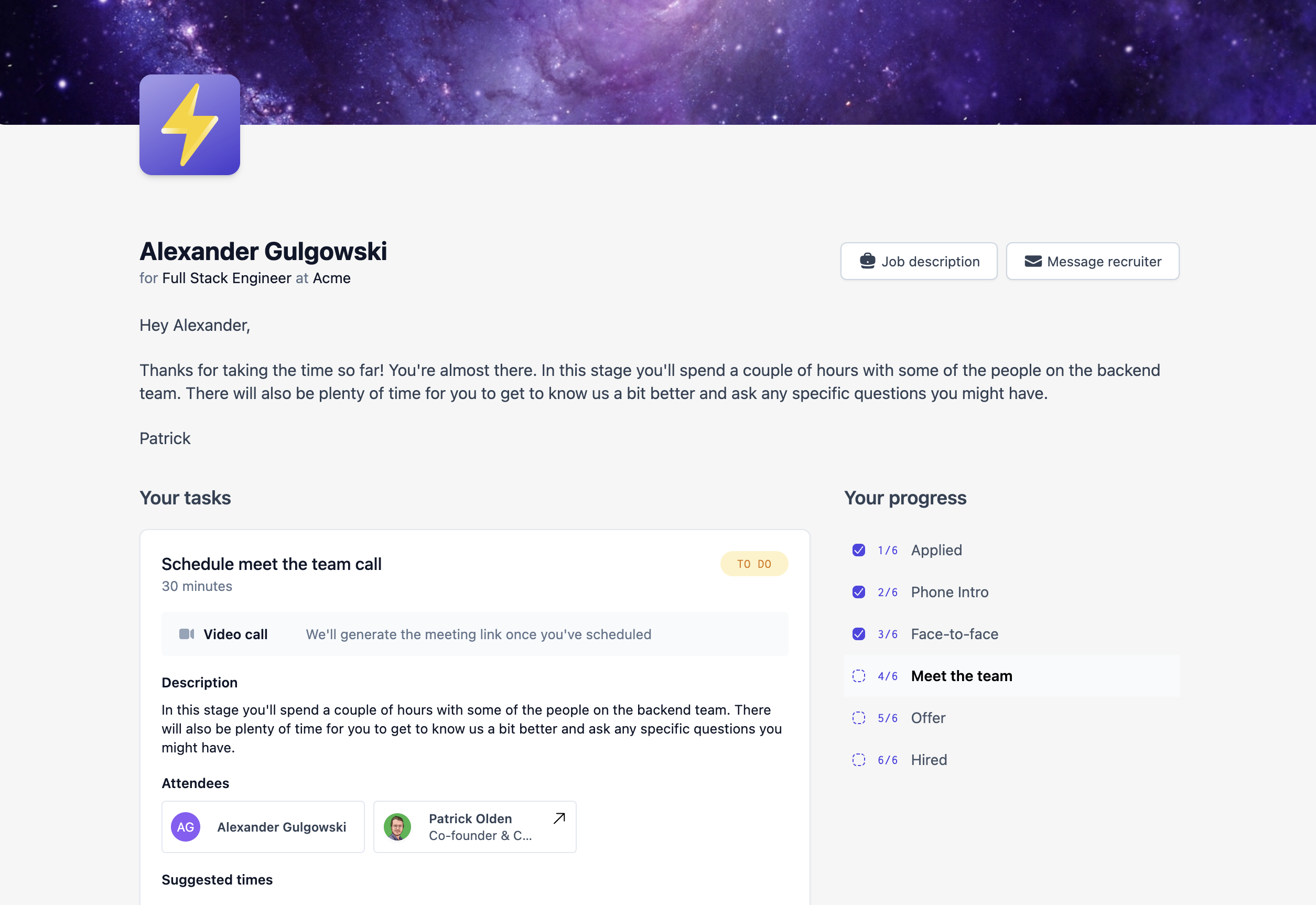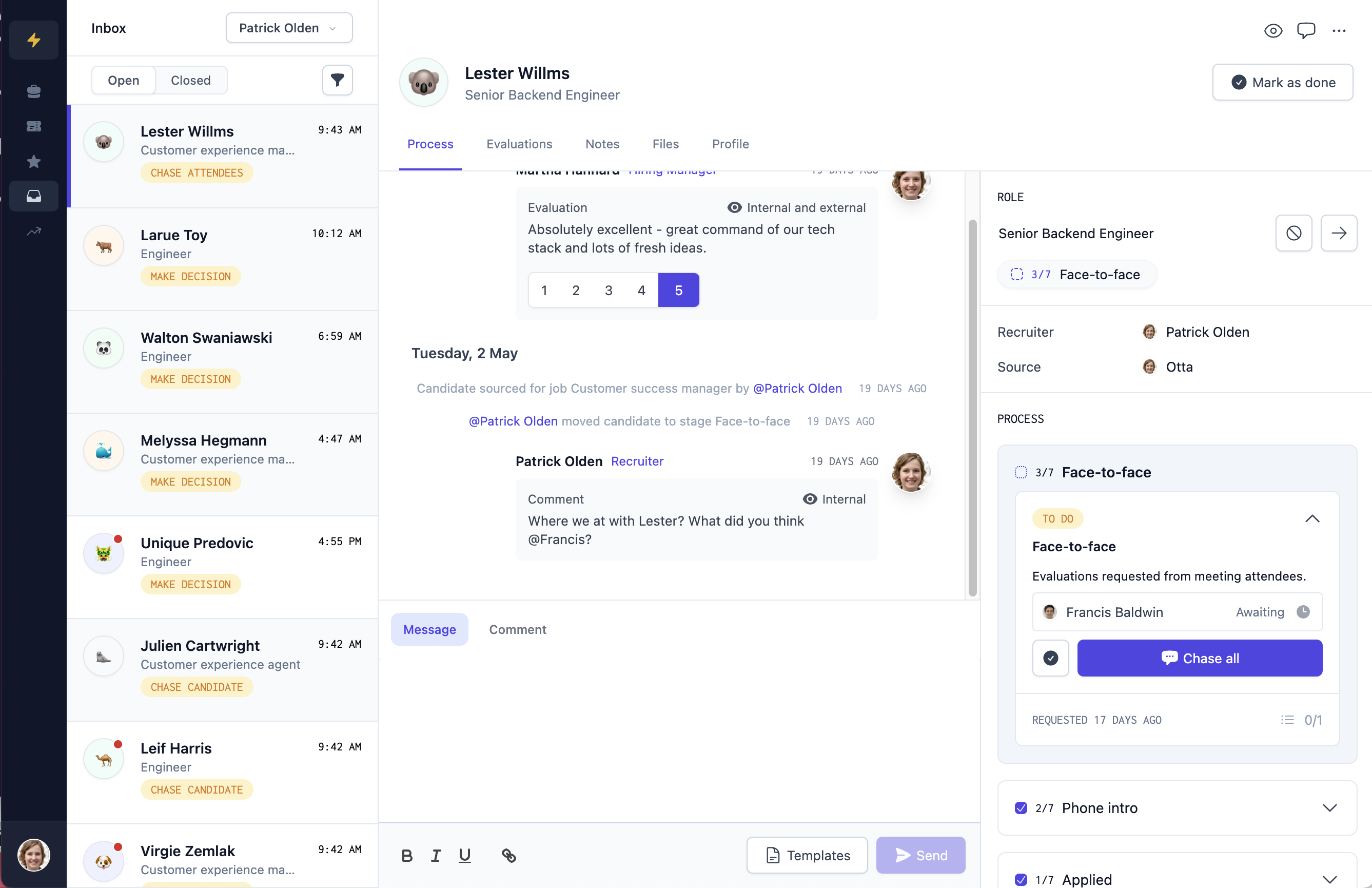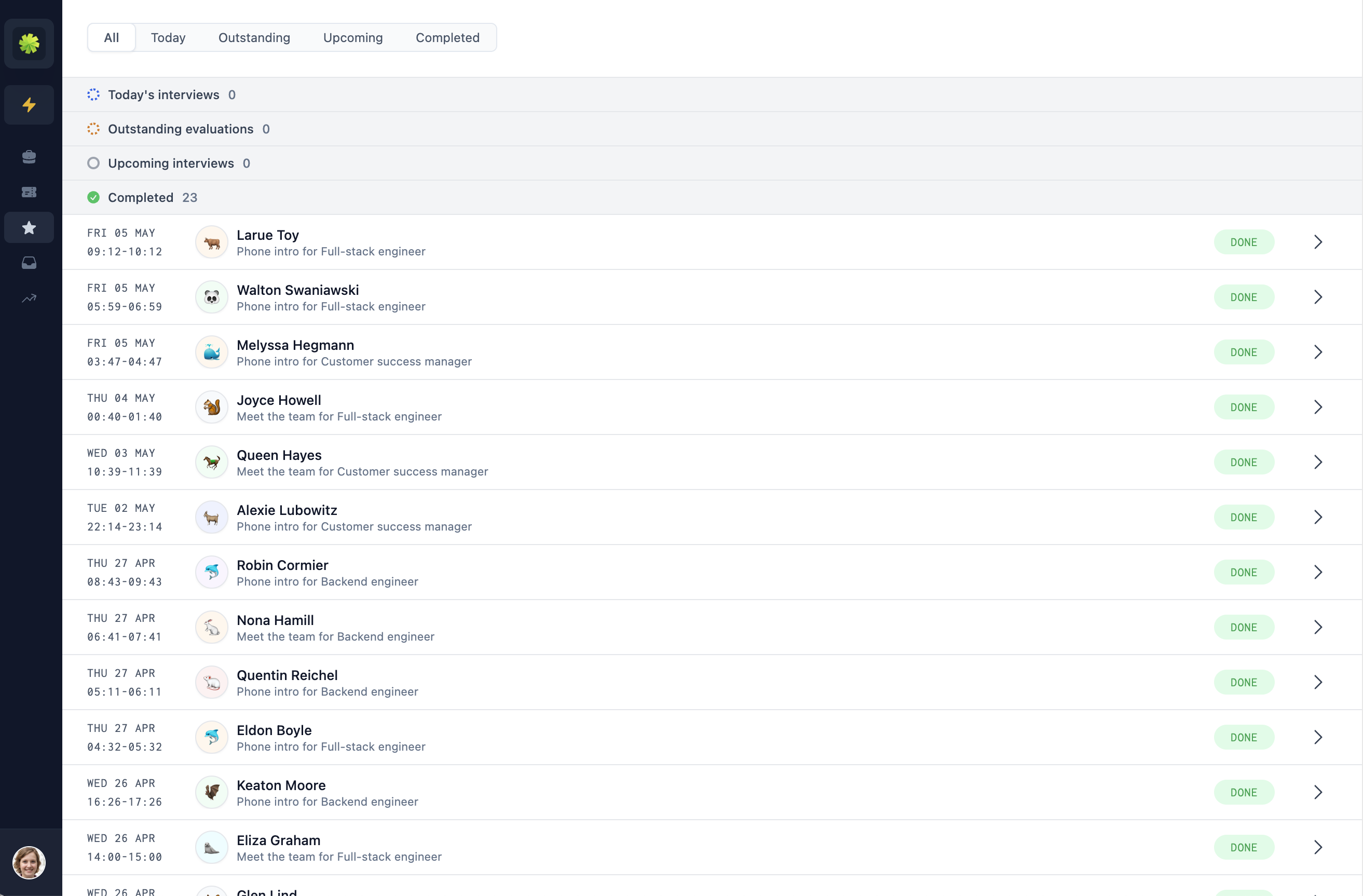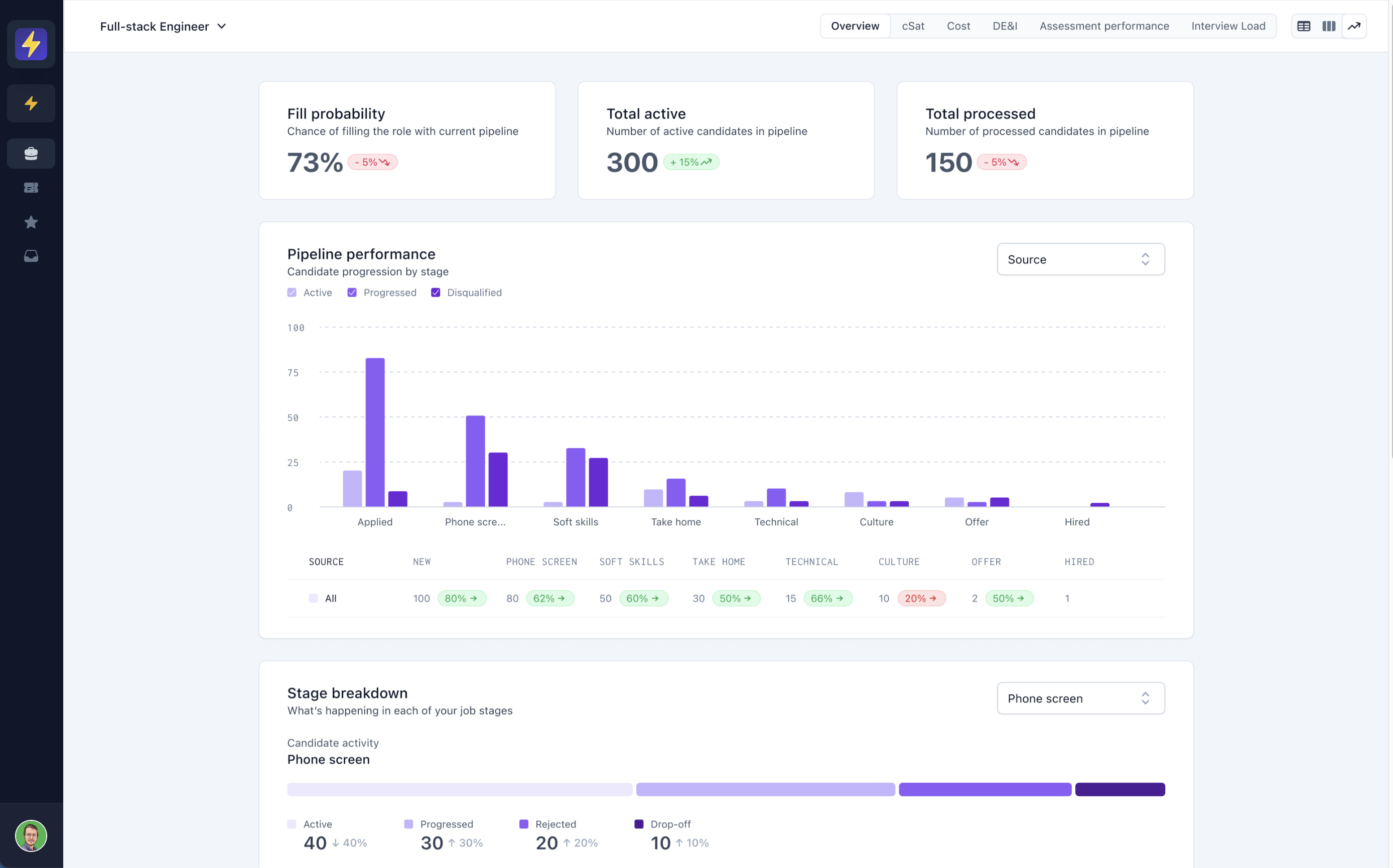
Prologue
13 minutes
Candidate-first
wins the best candidates.
Find out how.

Inbound
Agency recruiters, job boards, careers sites
Assessment
Recruiter screens, On-site interviews, Take-homes
Traditional hiring
1999 – 2018
In the early days of startup hiring, finding high quality candidates was a straightforward process. Posting a role to the relevant job board would yield strong profiles. Alternatively, agency recruiters could put forwards great candidates (albeit for a fee).
Startups were then free to fully focus on selecting the best applicants for the role. The entire recruitment process was built to serve this idea: startups copied the intense interview processes of Google and Airbnb, software emerged to screen candidates more efficiently (HireVue, Codesignal), and canonical advice guided teams on how to make the decision to hire (Bezos's Bar Raisers, Horowitz's Lonely Decision).
The defining feature of this paradigm was that startups were not required to think deeply about how to sell themselves or the positions they were hiring for. Candidates were already bought-in by virtue of having applied or by having an agency recruiter whose commission depended on them accepting an offer. This approach worked well for decades.

💪
Candidate power
The transition: candidate power
2019 – 2021
Towards 2019, as the tech industry matured, startups noticed that their traditional hiring methods had stopped working.
First, the influx of quality applicants slowed down. Then, the most promising either withdrew from the process or accepted offers elsewhere. Salary expectations soared, while candidates refused to participate in the multi-step interview processes that had been built over the preceding years. The demand for talent had reached dizzying heights and the size of the tech workforce hadn't kept pace to match.
Simultaneously, candidate expectations had transformed. Seeking a paycheck was no longer enough — candidates sought a sense of purpose to the hours they were going to dedicate to work each week. Unless you could clearly communicate how your employment proposition aligned with their aspirations, your chances of securing the best diminished considerably.
Additionally, the imperative for diversity compounded these challenges. Finding candidates who not only possessed the required skills, but also contributed to a diverse and inclusive workplace added an additional layer of complexity that put unprecedented pressure on TA teams.

Outbound
Cold, Referrals, Talent pools
Closing
Building buy-in, understanding candidate's PoV
Candidate-first hiring
2022 – now
In response, startups had to change their tactics. Firstly, they built in-house (or embedded) TA teams that could respond to this changing landscape. Next, they overhauled their hiring processes: this involved investing in Employer Branding initiatives, adopting tools for proactive outbound (Gem, Seekout, HireEZ) and placing a renewed emphasis on the ‘candidate experience’ throughout the hiring journey.
The most progressive companies, however, went one step further and adopted a fully Candidate-first hiring approach. In essence, the candidate-first approach shifts the hiring goal from solely identifying the best candidates in the process to proactively attracting the best from the start and successfully closing them on the opportunity. By employing this strategy, startups are able to attract and secure the absolute best candidates, even those in high demand.
With the candidate-first approach, every interaction with candidates is considered from their point of view. How does your company's mission, culture, and product align with their unique motivations and aspirations? How can you convincingly demonstrate that your employment proposition, along with the assessment steps required, is truly worth their time and consideration? And how can you build an organization that achieves this at scale? This approach represents the logical and radical culmination of the ‘candidate experience’ framework that preceded it, and it is the only effective response to the rapidly changing recruiting environment we find ourselves in today.

Traditional hiring
Available candidates
Worse
Better
Candidate-first hiring
Available candidates
Worse
Better
The unlock
In the face of a recent slowdown in the growth of tech, startups might legitimately wonder if candidate-first is still necessary today. The answer is overwhelmingly yes.
The primary reason why is unchanged from the boom days of 2021 – it enables teams to win candidates that until now they've considered totally out of their league. The competition for the very best talent continues with the same fervour as ever.
Moreover, adopting a candidate-first approach allows companies to build genuine buy-in, a feat that compensation or benefits alone cannot achieve. Instead of solely emphasizing financial incentives, startups can highlight their fresh and compelling mission and story, the people the candidate will get to work with, and the professional journey on offer. This results in better-suited and more successful hires.
Conversely, relying solely on traditional hiring methods carries the inverse risks. When an organization loses its ability to captivate candidates with a compelling vision, it becomes increasingly reliant on compensation as the sole motivator and recruitment tool. This approach rarely leads to startup success.
1. Treat candidates as equals
The biggest challenge in adopting a candidate-first approach lies in delivering a personalised, white-glove experience to your candidates at scale (especially as they get more advanced in the process).
To achieve this, the hiring journey itself should be leveraged as a canvas to build rapport with candidates. Every interaction should embody the following principles:
Transparency
The tech workforce wants to work in cultures of openness and honesty. They also want to see that your organisation can follow up on commitments it makes. By making your recruitment process as transparent as possible you will tick both boxes.
Reciprocity
Acknowledging that the recruitment process is a two-way street immediately sets a respectful tone. Giving your candidates the opportunity to direct the process (in specific ways e.g. inviting them to interview you) demonstrates that you value their perspective and take their aspirations seriously.
Constant engagement
Leaving candidates in the dark about the progress of their application is never acceptable. A step better than just updates is to constantly engage them with relevant (ideally personalised) information and communication that adds a sense of momentum to the process.
Authenticity
Rapport is built between humans, not corporate entities. Throughout their interactions with your team, candidates should feel they have gained an authentic glimpse into your people, their values, and what truly drives them.
Amazement
While meeting the above principles is commendable, it's vital to go the extra mile to stand out. To leave a lasting impression, offer something extraordinary – a touch that sets your organization apart from the rest.



Pick your compensation mix
Base Salary
79%
Equity
21%
$124,000
$43,000

acmecorp.com
How we got to 100k DAUs
Recommended for you

Jessica will submit your feedback

Max Hershen
Chief Technology Officer
Bio
I'm the CTO at Acme. I'm responsible for our tech, and making sure it's able to serve our global customer base... Read more
Working Styles
💻 Hybrid worker🌙 Works best in the evening🚁 Loves working across teams

How Prologue can help
Prologue is specifically built to help you build buy-in with your candidates. In Prologue, candidates have access to an (automatically) personalised, branded view into their own hiring journey; a place where they can understand where they're at in the process, collaborate with the hiring team on their application, self-serve the administrative work, and get an authentic glimpse into the people and what it's like working with you.
Find out more2. Stop doing admin, start closing
Recruiters play the critical role of guiding candidates through the process, but are today distracted by data entry, scheduling, and other low-value tasks. To achieve candidate-first hiring, it is essential to grant recruiters the time and opportunity to engage with each candidate on a deeper level by talking with candidates over the phone, understanding their progress in other processes, and gaining insights into what truly motivates them.
Automation is a prerequisite to minimizing administrative burdens, from sourcing candidates to collecting feedback and composing personalized messages. By streamlining these tasks, recruiters can focus on meaningful interactions.
Additionally, much of the craft of being a successful candidate-first recruiter extends beyond technology. Recruiters know that candidate health, tracking alternative processes, and uncovered candidate-drivers should inform the trajectory of promising candidates (such as scheduling interviews with relevant individuals). Striving to systematize this expertise enhances efficiency and consistency in the hiring process.



Next steps
Last engagement
Status

Max Henderson
Backend engineer
Patrick
Message Received
3 days ago
Soonest
Preferred order
Fairest load

Jessica

Arjun

Capucine
Skills Interview
12.15pm - 1pm
Culture Interview
1pm - 1.45pm
Manager Interview
1.45pm - 2.30pm
Suggested Candidate Feedback
Generated with AI based on interview notes.
Send Now
We did notice an opportunity for growth in your practical understanding of microservices. We recommend diving deeper into topics like service discovery, load balancing, and containerization. A book we like is “Building Microservices” by Sam Newman that could help you build expertise in this area.

How Prologue can help
Prologue is designed to liberate recruiters from tedious admin, and free them to what they're best at – connecting with candidates at a human level. Extensive automations, AI-assisted workflows, intelligent scheduling and more make this possible.
3.Build a candidate-obsessed organisation
One of the biggest hurdles to overcome in candidate-first hiring lies in getting buy-in from your hiring teams. Unlike the traditional hiring method, where the team's role primarily revolves around resume screening and interviews, in candidate-first hiring, they also play a vital part in closing top candidates.
The hiring team are involved throughout the process. Initially, when sourcing, a compelling message from a hiring manager can make or break a candidate's interest. Once in the process, candidate-first hiring necessitates transparency and authenticity from the organization – which in turn requires the team to give timely feedback and be available for interviews. Lastly, when it comes to closing candidates, the team is best positioned to effectively sell the role, as they are who the successful candidates will ultimately work with.
To make this possible, it is crucial to make hiring enjoyable for the team. Crafting engaging interviews, adopting high quality software to orchestrate the process, and supporting their growth (e.g. in interviewing skills) can make hiring something the team want to do.
Furthermore, adopting a candidate-first hiring approach requires a cultural shift within the team. They need to take pride in their contributions to the hiring process, and feel that their efforts are recognized and valued equally alongside their regular responsibilities. Doing this can be more complex, but if achieved it can be a galvanising way to build team-cohesion and commitment to your mission beyond just your recruitment processes.



What is the difference between grid and flexbox, and when would you use one vs the other?
Add notes here
Suggested candidate offer message
Generated with AI based on your interview notes.
Submit
Hey Joe! I wanted to let you know I'm genuinely excited about the prospect of you joining our team. Your technical expertise, knowledge of Scala, and problem-solving skills truly stood out during our interview. Take your time to decide... then choose us!

# candidate-feedback

🎉 A candidate just gave @Tom great feedback. This is his 5th interview this week!
Score: 5/5
Comments: Really enjoyed chatting with Tom - felt like I learnt a lot during the interview.

How Prologue can help
Prologue is designed to turn your team into a candidate-obsessed machine. From celebrational Slack notifications when great feedback comes in, to a beautiful UI your team will love using, Prologue is built to get your team bought-in and capable of delivering an incredible candidate-first experience.
4. Make sure it's working
The final hurdle in candidate-first hiring is orchestrating the entire candidate-first effort at scale. With traditional hiring, the effect of a bottleneck in your processes was simply a longer time-to-hire (unfortunate, but not make-or-break). With candidate-first, things need to be working before your dream candidate enters the pipeline.
To do this, you can monitor a broader set of metrics than traditional hiring – offer conversion, engagement statistics, stage drop-offs, and candidate health and satisfaction are just a few. Trusting this data and then building insights and SLAs from it is critical to success. Doing this in real-time is also required, as candidate-first requires you to be significantly more reactive to candidate needs.




Max Henderson
Backend Engineer
Approve

Role
Fill probability
Summary
Senior Product Manager
1 candidate offered, 2 in last interview.
Full-Stack Engineer
5 candidates in later stages.
Senior Full-Stack (NA)
Adverse dropoff in tech test.
Marketing Manager
Insufficient sourced candidates.

How Prologue can help
Prologue helps you build a world-class TA function with real-time observability and monitoring across all of your hiring efforts. We help you collect the data that matters in the candidate's dashboard (like DE&I information and cNPS). Next we give you access to this and a huge array of more advanced information — candidate health scores, offer quality (derived from benchmarked data) and predicted fill dates — to build your own reports and set SLAs against.
Find out more